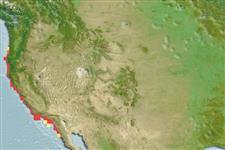>
Ovalentaria/misc (Various families in series Ovalentaria) >
Embiotocidae (Surfperches)
Etymology: Amphistichus: Greek, amphi = on both sides + Greek, stix, -ichos = row (Ref. 45335); koelzi: Named after Walter Koelz, U.S. ichthyologist (Ref. 6885).
More on author: Hubbs.
Environment: milieu / climate zone / depth range / distribution range
Ecología
marino demersal; rango de profundidad 0 - 9 m (Ref. 2850). Subtropical; 49°N - 26°N, 125°W - 112°W
Eastern Pacific: near Cape Flaterry in Washington, USA to northern Baja California, Mexico. Recorded 32 km from the Canadian border (Ref. 6885).
Tamaño / Peso / Age
Maturity: Lm ? range ? - ? cm
Max length : 31.0 cm TL macho / no sexado; (Ref. 6885)
Espinas dorsales (total): 9 - 11; Radios blandos dorsales (total): 24-28; Espinas anales 3; Radios blandos anales: 26 - 32. Generally silvery overlaid with brassy tones; back bluish or olivaceous; lower head and lower anterior part of body tinged with red; sides with series of brown speckles which form rough narrow vertical bars; pectorals plain, other fins usually reddish (Ref. 6885).
Adults occur usually in sand beaches in surf (Ref. 2850). Viviparous, female carries the developing young (Ref. 205).
Life cycle and mating behavior
Madurez | Reproducción | Puesta | Huevos | Fecundidad | Larva
Viviparous, female carries the developing young (Ref. 205).
Eschmeyer, W.N., E.S. Herald and H. Hammann, 1983. A field guide to Pacific coast fishes of North America. Boston (MA, USA): Houghton Mifflin Company. xii+336 p. (Ref. 2850)
IUCN Red List Status (Ref. 130435)
Threat to humans
Harmless
Human uses
Pesca deportiva: si
Más información
ReferenciasAcuiculturaPerfil de acuiculturaRazasGenéticaElectrophoresesheritabilidadEnfermedadesProcesamientoNutrientsMass conversion
Herramientas
Special reports
Download XML
Fuentes de Internet
Estimates based on models
Preferred temperature (Ref.
123201): 12.2 - 17.8, mean 15.3 °C (based on 49 cells).
Phylogenetic diversity index (Ref.
82804): PD
50 = 0.6250 [Uniqueness, from 0.5 = low to 2.0 = high].
Bayesian length-weight: a=0.01905 (0.00831 - 0.04372), b=2.97 (2.77 - 3.17), in cm total length, based on LWR estimates for this (Sub)family-body shape (Ref.
93245).
Nivel trófico (Ref.
69278): 3.4 ±0.2 se; based on size and trophs of closest relatives
Resiliencia (Ref.
120179): Medio, población duplicada en un tiempo mínimo de 1.4-4.4 años (Assuming tm<5).
Fishing Vulnerability (Ref.
59153): Low vulnerability (21 of 100).
Nutrients (Ref.
124155): Calcium = 99.2 [54.6, 182.5] mg/100g; Iron = 1.05 [0.59, 1.86] mg/100g; Protein = 18.6 [17.6, 19.7] %; Omega3 = 0.226 [0.132, 0.386] g/100g; Selenium = 15.9 [7.3, 33.7] μg/100g; VitaminA = 12 [3, 41] μg/100g; Zinc = 0.792 [0.546, 1.208] mg/100g (wet weight);
